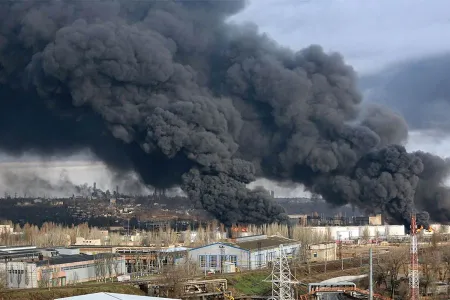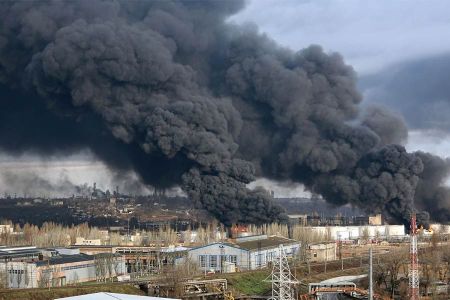From People and Nature
By Simon Pirani
Even in the midst of war, there is a struggle for Ukraine’s energy future.
It’s one that international allies of Ukraine’s social movements need to pay attention to, because states like the US and UK, and international organisations like the European Union, will be influential in how that tussle turns out.
In almost every country in the world there is a battle for influence between partisans of renewable, decentralised energy production, and those of legacy nuclear or carbon-intensive methods, who often have deeper pockets and stronger political connections.
But in Ukraine, that struggle is intensified by the unprecedented catastrophe inflicted on its energy sector by the Russian military, and the resultant urgency to invest.
“No European power system has ever suffered, endured and withstood such large-scale destruction, including during the first and second world wars”, a report by the Energy Charter Secretariat, an inter-governmental body, stated last month.
In May this year, more than half of Ukraine’s pre-invasion electricity generation capacity (27 gigawatts or GW), was occupied or damaged. That was before the disastrous destruction of the Kakhovka dam on 6 June, likely from within. Fears of sabotage at the Zaporizhya nuclear plant, Ukraine and Europe’s largest, remain.
Meanwhile, a confidential draft strategy document suggests that Ukraine’s government is planning to long-delay its plans to phase out coal.
Ukraine’s just transition coalition
Mining communities and environmentalists in Ukraine have joined forces in an effort to put decentralised, renewable electricity generation at the centre of a just transition away from coal.
In September last year, mayors of 11 mining towns issued an open letter, calling for a just transition away from coal with decentralised renewables as the main plank of energy policy. Heating could be decarbonised by gradually replacing gas and coal with renewably-powered heat pumps, they wrote. Coal mine water could be be tapped for heat.
Sixteen local government bodies from coal mining areas last month made another call for non-fossil-fuel-based economic development and for “decarbonisation and decentralisation of the energy system”.
Campaigners joined their voices to this call in London last month, where ministers from Kyiv and western governments met to discuss post-war reconstruction – and added that Russian attacks are a reason to commit to the decentralised and renewable agenda, not withdraw from it.
“Ukrainian municipalities have not waited for the end of the war to rebuild and provide water, heat, electricity, transport, medical care other vital services”, an alliance of civil society groups said, in an appeal to the London intergovernmental conference. Municipal-scale renewable projects and energy efficiency schemes are “already bankable” and increase communities’ resilience.
What is needed now are low-cost loans in hryvnia, Ukraine’s currency, to reduce the risk of currency fluctuations. Also needed are changes to electricity sector regulation – for example to allow “net metering” to integrate small wind and solar projects with the grid – to push electricity system decentralisation forward.
The emphasis should be on solar and wind projects at municipal, community or even household scale, that can be rapidly hooked up to the grid.
“A mix of solar PV [photovoltaic] panels, batteries and diesel generators” is “cost-optimal to complement unreliable grid electricity”, research published in February by Low Carbon Ukraine found.
The research group, funded by the German government, calculated how best to cope with constant power cuts, using the example of a Kyiv school.
These wartime measures can pave the way to a much bigger post-war role for decentralised renewables, Anna Ackermann of the International Institute for Sustainable Development told an on-line event prior to last month’s London conference.
Empowering local government structures is not in itself controversial in Ukraine, which has had a programme of political decentralisation since 2014. And the government in principle supports physical decentralisation of electricity supply. But an appropriate regulatory regime is desperately needed, say the civil society groups.

International financial institutions and western governments can help by providing risk insurance and low-interest loans in hryvnia to municipalities, they argue.
The push for local renewable electricity projects is one part of a wider discussion about the future of Ukraine’s energy system.
Traditionally, Ukraine has relied heavily on nuclear plants for electricity, and coal and gas for both electricity generation and combined heat and power plants (CHP) that supply district heating systems. Hydro power also plays a role, and prior to the Russian invasion, wind and solar generation expanded impressively.
Wind and solar development, plus energy efficiency measures, are without question the best options, not only to empower municipalities and communities, but also for Ukraine to play its part in avoiding dangerous climate change. But the municipalities and civil society organisations advancing these plans are at odds with powerful fossil fuel and nuclear lobbies, who have an eye on reconstruction funds, and with big electricity companies who have their own views of what “transition” means.
Coal
The speed at which Ukraine phases out coal, closing both mines and coal-fired power stations, was contentious long before the Russian invasion. In 2017 the government set a 2035 deadline to stop electricity generation from coal; DTEK, Ukraine’s largest electricity and coal company, suggested 2040. These targets are not ambitious enough to meet climate policy goals, and the European Commission urged a tighter schedule.
DTEK’s mines and power stations have been devastated by bombing, and since 2014 hundreds of its employees have died in the war. It has its own plans for energy transition, and has invested in wind farms. DTEK is also politically powerful: Rostyslav Shurma, who answers for energy policy in the presidential administration, and Denis Shmyhal, prime minister, both entered politics after careers in DTEK management.
The government’s mixed messages may reflect the views of DTEK and other energy companies on one hand, and international political pressure to quit coal on the other. Arguments about ending coal-fired electricity generation also obscure the need to cut coal use in industry.
In London last month, deputy energy minister Yaroslav Demchenkov repeated the government’s pledge to phase out electricity generation from coal by 2035. But the government’s recent draft energy strategy envisages that coal use, mostly in industry, will still be at between a third and a half of the present level in 2050. The document has been kept secret under wartime legislation. The strategy includes scenarios indicating that the government will aim to manage down consumption of “solid fossil fuel” (overwhelmingly coal) from 25 mtoe in 2023 to between 8 mtoe and 12.5 mtoe.
Gas
Ukraine stopped importing gas directly from Russia in 2016 and now produces nearly all that it consumes. But the government proposes to invest a big chunk of post-war recovery funds into new gas production: $18 billion at existing fields and $11 billion for new fields in the Black Sea. Oleksiy Chernyshov, new chief executive of the state-owned gas producer, Naftogaz Ukrainy, discussed these plans with ExxonMobil, Chevron and Halliburton on a trip to Washington in April.
Economists and energy researchers say these proposals go in exactly the wrong direction. The government’s recovery plan has no provision for energy efficiency spending – although tackling Ukraine’s heat-leaky housing stock and upgrading its Soviet-era district heating could slash the amount of gas they need.
Big gas investments would “hinder the energy transition, increase the carbon intensity of the economy and increase exposure to the impacts of climate change”, Anastasiia Zagoruichyk and her colleagues at the Smith School of Enterprise and the Environment of Oxford university warned in a paper published last month.
Starting big new offshore gas projects would create “carbon lock-in” for the energy sector, and heighten the risk of climate-related physical risks such as storms, coastal erosion and sea level rise.
The government’s plans to plunge $2.5 billion into Ukraine’s gas transport pipeline system, which carries Russian gas to Europe, have also come under fire. Serhiy Makogon, former chief executive of the state-owned gas transport company, said in an on-line forum last month that the system – which is now nine-tenths empty – should be repurposed for energy storage and other uses, to support the development of a renewables-focused energy sector.
Nuclear
The secret draft energy strategy, reflecting strong political support for nuclear, envisages increasing nuclear plants’ annual electricity output from 75 terawatt hours (TWh) in 2020 to 106 TWh in 2032, keeping their share of the total above 50%. The state electricity company Ukrenergo, in a conference presentation earlier this year, called for $57 billion in investment for electricity generation, of which $42 billion would be nuclear.
In January the government approved a plan to move forward the long-delayed expansion of the Khmelnitsky nuclear plant, using technology from Westinghouse of the US. Energy minister German Galushchenko, a former nuclear industry executive, in March announced plans to switch Ukrainian nuclear plants, which historically imported fuel from Russia, entirely to Westinghouse-supplied fuel.
Social movements and environmentalists say long-term investment in expensive nuclear capacity is not just unnecessary, but dangerous. Svitlana Romanko of Razom We Stand, the energy policy campaign group, argues that “we need real financial and technical support to provide reliable power and heating systems for the Ukrainian people at affordable cost” – and that means abandoning “hypothetical future or hybrid scenarios” using nuclear or fossil fuels.
Researchers at the Institute for Economics and Forecasting in Kyiv showed, in a paper published in May, that even existing nuclear plants could be retired, and electricity generation shifted to renewables, “in a cost-competitive manner”.
The European Union, and the UK and US governments, influence these policy discussions. Brussels officials have floated exploitative plans to use Ukrainian renewables, that should supply Ukraine’s electricity grid, to make hydrogen for export. Campaigners combating the fossil fuel and nuclear lobbies in those countries could and should make common cause with their Ukrainian counterparts.




